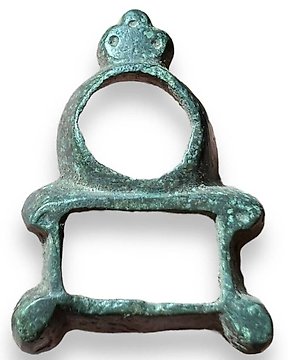
Gammel keltisk stamme -Bronze Smuk amuletvedhæng-Talisman til beskyttelse.-25 mm-3.-1. århundrede f.Kr.-god patina. Amulet (Ingen mindstepris)
Nr. 85074697

Nr. 85074697

Antigua Roma : excelente ídolo colgante en forma de águila imperial ,utilizado por los soldados romanos como símbolo de poder y supremacía militar,La imagen más emblemática de toda la historia militar,con muchísimo detalles de plumas ,poco inusual excelente calidad,a falta de enganche de suspensión
"ATENCIÓN"
NO SE HACEN ENVIOS FUERA DE LA UNION EUROPEA
Sallust recounts that Gaius Marius first used it as an insignia in the war against the Cimbri, handing one to each legion, and such use has remained ever since.
In the time of Gaius Julius Caesar it was made of silver and gold. From the Augustan reform onwards, the material used was gold alone. The eagle was guarded by the first centuria of the first cohort, kept at the camp (together with the signa militaria) inside the aedes signorum, one of the buildings of the Principia (headquarters of the legion).
The eagle only left the Roman camp when the entire legion moved, under the responsibility of a legionary non-commissioned officer, the Aquilifer, who not only had to ensure its safekeeping, but was also in charge of carrying it into battle and defending it even at the cost of his own life. In this sense, the aquilifer can be compared to an ensign, a young officer in modern armies, and the eagle itself can be regarded as a flag of war or a standard.
It was a sign of serious defeat to lose it, an event that happened on rare occasions such as during the Battle of the Teutoburg Forest in 9 A.D., when as many as three aquilae fell into the hands of the Germanic enemy. During the Batavian revolt, however, the handing over of the respective aquilae to the Germanic enemy caused the four entire legions to disband. This happened in 70 to the I Germanica, IIII Macedonica, XV Primigenia and XVI Gallica In other cases it was a sign of great shame and ignominy, but not of disbandment, as happened to legio V Gallica in 17 BC or legio XII Fulminata in 66 during the First Jewish War. The insignia were therefore defended to the death, or, during battles, stuck into the ground in such a way as to prevent their loss. The eagle's head was often depicted on the pommel of the Parazonium of Roman generals and on the breastplates of senior officers.
Metal: plata
Peso: 13'9 g
Diámetro : 29'1 mm
Comprado por el propietario actual en 2010 en Austria Wien coleccionista privado
Recopilado desde 1990
Historia de propietarios anteriores antigua colección privada Austriaca B.M.G
Declaración de procedencia vista por catawiki
Información importante: el vendedor tiene derecho a enviar este lote
El vendedor se encargara de que se tramiten todos los permisos necesarios
El vendedor informará al comprador sobre esto si tarda más de unos pocos días
Sådan køber du hos Catawiki
1. Opdag noget særligt
2. Afgiv det højeste bud
3. Foretag en sikker betaling